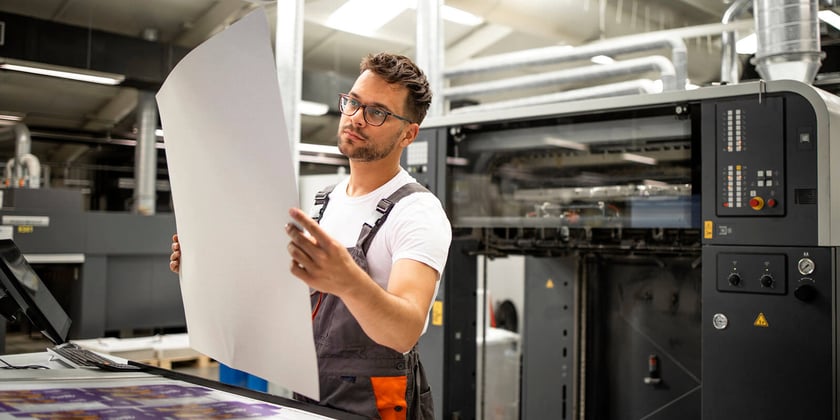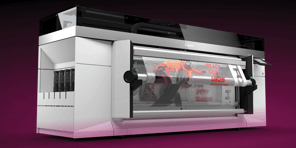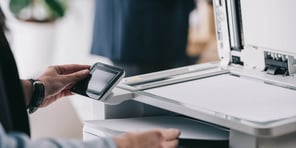While it may seem like a no-brainer to invest in your own commercial printer, the true cost of ownership can often come as a surprise.
Spoiler alert: It’s not just the cost of the printer itself.
In this blog, we’ll discuss what commercial printing is, a breakdown of the different costs associated with it and factors to consider when deciding whether investing in a commercial printer is the right move for your business.
What is Commercial Printing?
A commercial printer is a type of printer that is designed and manufactured for organizations that require high-quality printing capabilities for their marketing materials, publications and other printed materials.
Commercial printers are typically larger and more robust than consumer-grade printers, with greater printing speeds, higher paper capacities and more advanced printing technologies.
They’re capable of printing on a wide variety of paper stocks, such as coated and uncoated papers, as well as numerous synthetic stocks that a consumer printer would be unable to produce. A few examples of printed products include brochures, flyers, event invites, bills/invoices, catalogs and books.
How Much Does a Commercial Printer Cost?
The true cost of owning a commercial printer can vary greatly from business to business – there’s no one-size-fits-all in the print industry.
Here’s a breakdown of the different costs you can expect to pay when investing in a commercial printer for your organization:
Initial Costs
The cost of a commercial printer can vary greatly depending on several factors, including the type of printer, the brand, the features and the printing capabilities.
If you’re new to commercial printing and have lower print demands, you can expect to pay anywhere from $15,000 to $70,000 for the machine itself.
Organizations that are already well established and are looking to keep up with the high demands of their clientele may pay anywhere from $100,000 all the way up to $1,000,000+, with all the bells and whistles included.
Investing in a commercial printer is more than just buying the machine, there are several activities that can be performed on printed material after printing that can increase how much you spend.
Finishing Equipment
Print finishing services are important because they give the print a professional look, a long-lasting impression and maximize the value. A few major finishing processes include, but aren’t limited to: cutting, binding, folding, collating, coating and laminating.
Cutting Equipment
Say you’re printing business cards for example. Are you only going to print one business card per sheet? Probably not.
You’ll most likely want to lay out multiple business cards on one sheet to get the best value, which means you’ll need equipment to cut them. Cutting equipment can vary greatly, with cutters starting as low as $1,500.
However, you'll most likely want to do more than just one type of cut — how about creasing, perforating or die-cutting? Versatile cutters can range from $10,000 to $100,000+ depending on how much automation you need.
Lamination Equipment
Similarly, if your organization sends products through the mail, you may want to UV coat your prints or laminate them to protect them from the elements. Lamination equipment can range anywhere from $2,000 to $30,000, but the sky is the limit.
Ongoing Costs
In addition to the initial costs, there are other factors to consider, such as ongoing maintenance and operating costs.
Organizations who invest in their own commercial printers typically have a service or maintenance agreement in place (think of this agreement as insurance in case your machine jams or breaks down unexpectedly).
A standard service contract typically includes:
- Consumables (toners, drums, waste bottles, etc.)
- Preventative Equipment Maintenance
- Replacement Parts
- Labor and Materials for Service Cost
All of the above is wrapped into what’s called a click charge, i.e. the charges associated with maintenance and support (excluding paper and staples).
Within a click charge there’s a click cost, which refers to the amount it costs per sheet/copy. For multicolor devices, click costs could vary from $0.033 to $0.08, depending again on the manufacturer, category of machine, number of copies produced per month, etc.
Say you run 10,000 color sheets in a month. At a click rate of $0.04, it would cost your organization $400 to print – that’s it. The only thing you would have to supply outside of that cost is the paper itself or staples needed for finishing.
Having a service or maintenance agreement helps you save time, increase productivity and most importantly, keep your ongoing costs well-managed.
Hidden Costs
On top of the initial purchase and ongoing costs, there are hidden costs you should be aware of.
When investing in a commercial printer, it’s important to take into account the time required for setting up print jobs as well as unexpected downtime due to printer malfunctions or repairs.
Preflight for Print
Have you ever created a flyer or poster, printed it out and it looks completely different than it did on the computer screen?
Ensuring that the digital files required for the printing process are all present, valid, correctly formatted and of the desired type, also known as preflight, is crucial, especially when it comes to commercial printing.
And if you don’t have a graphic designer or an individual on your team who’s familiar with the preflight process, this can be a time-consuming and costly task.
Printer Downtime
On the other hand, work can come to a standstill when a printer goes down. And if your business relies on printing to make profits, you’re out of luck until a technician comes out.
Lost productivity and downtime can cost your organization thousands of dollars in lost profits, so it’s important to partner with a reputable service and support team when investing in a commercial printer.
Ultimately, the initial cost you’re going to spend on a commercial printer depends on the printing needs of your organization.
If your organization is mainly looking to print for internal use, such as flyers, you could probably get away with purchasing a $20,000 machine. If your organization is looking for higher-quality prints or more complex projects, you’ll probably need to invest in a commercial printer with additional finishing equipment.
Buying vs. Outsourcing: What's the Difference?
As I’ve mentioned before, it’s important to consider the printing needs of your organization when assessing which solution is best for your business.
Your cost to outsource could range anywhere from 3 to 20 times the cost of printing in-house, but the exact cost depends on what you’re producing and how much you’re producing.
Example: Outsourcing vs. In-House
For example, let’s say you need to print 1,000 high-quality, full-color flyers. If you were to outsource the job to a commercial printer, the cost may be around $0.30 to $0.40 per flyer, which would come out to about $300 to $400.
On the other hand, if you were to print the flyers in-house, the cost will probably be significantly lower. Assuming you already have all the necessary equipment and a service or maintenance agreement in place, your cost per flyer could be around $0.04 to $0.06, bringing you to a total of about $40 to $60.
It’s important to recognize that the price you pay to outsource your prints will most likely be higher than in-house for a variety of reasons, such as:
- They own the machine and all of the finishing equipment
- They supply the paper and other consumables (toners, drums, etc.)
- They supply the employees operating the machines and ensure the files are setup correctly
Outsourcing commercial print may be more expensive upfront, but it can save you money by avoiding the need to purchase and maintain expensive printing equipment, as well as the time and labor costs associated with in-house printing. If you don’t have high print demands, outsourcing may be a viable option for your business.
By investing in your own commercial printer your business can save money in the long run by avoiding the cost of outsourcing while gaining the ability to print materials in-house.
Here are a few of the benefits associated with bringing your commercial printing in-house:
- Control: ability to adjust print quality, make changes to designs as needed and manage your printing schedule to meet deadlines
- Flexibility: ability to print on-demand and adjust print quantities as needed
- Convenience: eliminates the need to wait for external printing services and the potential for delays in shipping or delivery
Factors to Consider Before Purchasing a Commercial Printer
So, which solution is best for your business? When deciding between outsourcing your commercial print vs. bringing it in-house, consider the following questions:
- Do you have space for a commercial printer in your facility?
- Do you have somebody to operate the machine?
- Do you have someone who can design the files you need?
- How fast do your prints need to be produced?
- How many prints do you typically need to produce each month?
- What kind of finishing options do you need?
It’s important to note that the cost of a commercial printer is a significant investment for an organization. Carefully consider the features and capabilities needed to meet the specific printing requirements of your organization before making a decision.
Read Next: Downtime Is Bad Time: Increase Your Production Print Uptime

Caleb is a Production Print Account Executive with more than six years of experience in the print industry. He is always trying to find new ways for clients to retain and expand their business by offering the latest technology and thinking outside the box. In his free time, he enjoys recreational flying, snowboarding, camping and traveling with his wife and three young boys.




